Episode
4
The Last Place
on Earth
Written &
directed by
ADRIAN REDMOND
Production number 601-101D
Filmed in Alaska 1998-2000
Post production in Denmark 2001
Duration 51 minutes (English version)
Stereo PAL and NTSC
Non-broadcast release on VHS and DVD
Also available in
Danish and Greenlandic |
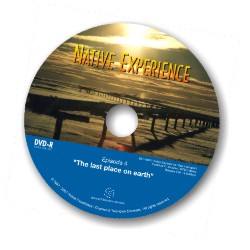 |
|
| |
| Living
with the consequences |
| |
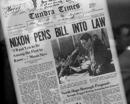 |
With
the passing of the Alaska Native Claims Settlement
Act in 1971, the way was open for the construction
of the Trans Alaska pipeline and with it the
exploitation of the huge oil reserves of the North
Slope.
The search for new oil deposits continued and soon
Prudhoe Bay was heralded as the greatest oil reserve
in the United States. |
|
|
| The
impact of industrial development was felt quickly
by communities throughout Alaska as thousands of
construction workers - primarily from the lower 48
states - descended on Alaska in pursuit of
employment and wealth. Alaska's communities -
particularly the rural Native communities, were
unprepared for the scale and tempo with which
development and the growth of a cash economy would
take place. |
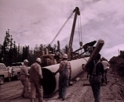 |
|
| |
| Whilst
the oil industry and many construction companies had
promised to create permanent employment for Alaska's
Natives, few long-term jobs were actually realized. When
the construction boom was over, the Natives had to adapt
to a new world - one in which the cash economy was
increasingly important, despite the lack of employment
opportunities for the Native population. |
| |
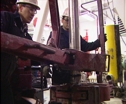 |
The
Native-owned ANCSA corporations took up the
challenge, amongst them the Athabascan Indian
regional corporation Doyon, which established a
drilling company in direct competition with
experienced rig operators on the North Slope. Within
two decades, Doyon Drilling has become the most
successful rig operator in Alaska, with one of the
best Native hire track records on the North Slope,
and boasts a performance and safety record which is
renowned throughout the oil industry. |
|
|
| Following
the enactment of ANCSA, Alaska's Natives embraced
development because they had few viable political
or economic alternatives. Likewise living
conditions in bush Alaska in the 60's and early
70's were lagging far behind the standards of
living conditions and public services enjoyed by
citizens elsewhere in urban America. The Natives
placed their faith and trust in the ability of the
industrial world to respect and protect their
natural resources at the same time as exploiting
them for profit. |
 |
|
| |
 |
Such
faith was severely undermined when, in 1989,
the oil tanker Exxon Valdez ran aground in Prince
William Sound, causing an oil spill the effects of
which have not completely subsided over 10 years
later.
The Exxon Valdez disaster contains important lessons
for industrial societies all over the world. |
|
|
| The
story of industrial development in the Alaskan
Arctic is one of both great opportunity and
frightening pitfalls - two sides of the same coin
- which illustrate that industrial development is
possible anywhere in the world - but not without a
price to be paid, often by the Native population
and their natural environment. |
|
|
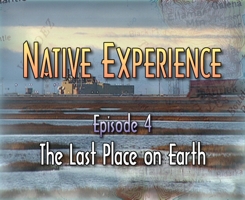
|
|
| The
Native Claims Settlement Act changes Native Alaska
irrevocably. Despite all the benefits which have
accrued from the act, the development which
followed it divided Native society in many ways -
economically, culturally, socially. The
traditional fabric of Native communities changed -
where once the community had been more important
than the individual, Native Alaskans were now
facing the American dream - a dream which for some
would come true, whilst for others it would prove
to be a nightmare. |
|
|
|
|
| It
is almost certain, that Alaska's Natives could not
have negotiated themselves a better deal - neither
in 1971 nor in the years hence. It is equally true
that ANCSA has given the Native population a
sizeable economic stake in the development of
Alaska's resources. But neither ANCSA nor any
other American legislation has ever given
indigenous people the right to choose for
themselves as to whether or when any development
should take place - therein lies the fatal flaw of
ANCSA. |
|
|
 |
Seen
from the point of view of many Inupiat Eskimos, the
moral and philosophical issues are simple - the land
is theirs, the oil is theirs, and the only morally
and historically correct course would have been to
grant the indigenous people of Alaska total
sovereignty to all of the land. Of course such a
conclusion to the Native lands claims would - in
1971 or today - be politically and constitutionally
impossible. |
|
|
| The
US has never removed a star from its flag, and
such a course of action would never have been
under discussion. So in the end ANCSA had to be a
compromise - and as such - would be doomed to have
its failures as well as its successes. |
|
| The
important issue for Native Alaska is to recognize
such failings for what they are - the shortcomings
of a solution which could never fairly address the
fundamental issues to the satisfaction of the
population of Alaska - Native and non-native.
Those Native organizations which have done well
since 1971, are those whose regions creation had
blessed with natural wealth, and whose leadership
have understood how best to harness the wealth and
exploit it politically and economically. |
 |
|
| |
 |
The
greatest impact of ANCSA lies therefore in the way
it changes Native society, replacing traditional
values and social structures with American or
Western industrial ways of organizing society,
managing the land, harvesting the wealth and
governing its people. Most Americans or Westerners
would argue that their system is the best that
mankind has ever evolved for managing the affairs of
man - and in their eyes, ANCSA was the right course
to follow. |
|
|
| Such
views of course deny the simple truth that
whatever the virtues of the Western world, it was
a question which the Native population should have
decided for themselves. This is the dilemma of
indigenous people throughout the world. |
|
| As
ANCSA divided the Native population - into have's
and have-not's, employed and unemployed, rich and
poor, rural and urban, educated or uneducated -
their perceptions and stories of life since ANCSA
have diverged - it depends on who you ask, and
from which perspective you are asking. |
 |
|
| |
| Episode
4 - so far the last film in the "Native
Experience" series - does not attempt to tell a
single chronological story - instead we examine some of
the aspects of development since ANCSA - from the
immediate boom impact of the construction of the Trans
Alaska Pipeline, to the social and economic changes which
followed and the impact of these on different communities.
Finally we examine the Exxon Valdez oil spill and the
lessons which can be learnt from the disaster. |
| |
 |
Episode
4 is entitled "The Last Place on Earth" -
inspired by the title song which was written by Mike
Faubion. For me the title represents the paradox of
the development of Alaska - Natives and non-natives
pursuing wealth and progress, but both disenchanted
by what they find - for many outsiders, work in
Alaska was the quest for wealth, for which hard work
away from home in an even harder climate was the
price - for many Natives, participating in the
construction boom gave immediate material gains, but
at the cost of changing their homeland forever. |
|
|
| The
following participated with their interview in
this episode - |
|
Morris
Thompson
Denny Denbrock
Dermot Cole
Willie Hensley
Jack Roderick
Gary Attla
John Shively
Charles Brower
Elise Patkotak
Jim Beckham
Ron Brower
Gary Harrison
|
|
| The
number of non-native participants in this episode,
compared with the foregoing episodes, illustrates
the degree to which the demographics of Alaska
have changed in recent years - whilst certain
political issues undeniably polarize Alaskans on a
native / non-native fault line (or at least an
urban / rural one) - it is true that the native
and non-native population groups - especially in
the rural areas typically continue to live and
work in harmony. |
|
As
the closing narration of the film suggests, "the
white population, many born and bred in Alaska,
were also working
to create progress without obliterating the land
they loved."
For many non-natives, Alaska is their home,
and has been for several generations. This was
undeniably "part of the clock" which
ANCSA could not wind back. |
 |
|
| |
| This
film makes a valuable contribution towards documenting the
history of the Alaska Native Claims Settlement Act and is
recommended viewing for Native and non-native audiences
alike. |
| |
|

|
| |
|
This
programme is dedicated
to the memory of
Athabascan leader, Morris Thompson |
|
|
|
(Producers note: The
dedication of this episode is particularly important to
me, as Morris Thompson was one of the first Native leaders
whom I met with in 1997, and whose guidance, help and
friendship sustained me on many occasions throughout my
filming travels in Alaska. His tragic death in January
2000 was a great loss for all Alaskans.)
|
|
|